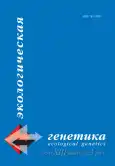Manifestations of resistance to acaricides in inbred lines of two-spotted spider mite in the process of disruptive selection
- Authors: Sundukov O.V.1, Tulaeva I.A.1, Zubanov E.A.1
-
Affiliations:
- All-Russian Institute of Plant Protection
- Issue: Vol 13, No 3 (2015)
- Pages: 76-84
- Section: Articles
- URL: https://journals.rcsi.science/ecolgenet/article/view/2414
- DOI: https://doi.org/10.17816/ecogen13376-84
- ID: 2414
Cite item
Full Text
Abstract
Keywords
Full Text
##article.viewOnOriginalSite##About the authors
Oleg Veniaminovich Sundukov
All-Russian Institute of Plant Protection
Email: Sunduckov.oleg@yandex.ru
PhD, Senior scientist, Laboratory ecotoxicology
Irina Anatolievna Tulaeva
All-Russian Institute of Plant Protection
Email: zubanov63@rambler.ru
PhD, scientist, Laboratory ecotoxicology
Evgeniy Aleksandrovich Zubanov
All-Russian Institute of Plant Protection
Email: zubanov63@rambler.ru
PhD, scientist, Laboratory ecotoxicology
References
- Беленький М. Л. (1959) Элементы количественной оценки фармакологического эффекта. Рига: АН Латв. ССР.
- Маурер Г. (1971) Диск-электрофорез. М.: Мир.
- Сингер М., Берг П. (1998) Гены и геномы. М.: Мир, Т. 2.
- Сундуков О. В. (2012) Этиология острой токсичности инсектоакарицидов и физиологические факторы, определяющие избирательность их действия на членистоногих. СПб.: Наука.
- Сундуков О. В., Тулаева И. А., Зубанов Е. А. (2014) Наследование признаков резистентности к акарицидам в инбредных линиях обыкновенного паутинного клеща. Экол. генетика. Т. 12 (3): С. 43-51.
- Урбах В. Ю. (1964) Биометрические методы. М.: Наука.
- Bass Ch., Field L. M. (2011) Gene amplification and insecticide resistance. Pest Manag. Sci. V. 67 (8): P. 886-890.
- Dermauw W., Ilias A., Riga M. et al. (2012) The cys-loop ligand-gated ion channel gene family of Tetranychus urticae: Implications for acaricide toxicology and novel mutation associaned with abamectin resistance. Insect Biochem. Mol. Biol. V. 42: P. 455-465.
- Karnovsky M. J., Roots L. (1964) A “direct-coloring” thiocholine method for cholinesterases. J. Histochem. Cytochem. V.12: P. 219-221.
- Kwon D. H., Yoon K. S., Clark J. M., Lee S. H. (2010) A point mutation in a glutamate-gated chloride channel confers abamectin resistance in the two-spotted spider mite, Tetranychus urticae Koch. Insect Mol. Biol. V. 19: P. 583-591.
- Leeuwen T. van, Pottelberge S. van, Tirri L. (2005) Comparative acaricide susceptibility and detoxifying enzyme activities in field-collected resistant and susceptible strains of Tetranychus urticae. Pest Manag. Sci. V. 61 (5): P. 499-507.
- Leeuwen T. van, Pottelberge S. van, Tirry L. (2006) Biochemical analysis of chlorfenapyr-selected resistant strain of Tetranychus urticae Koch. Pest Manag. Sci. V. 62 (5): P. 425-433.
- Leeuwen T. van, Tirri L. (2007) Esterase-mediated bifenthrin resistance in a multiresistant strain of the two-spotted spider mite, Tetranychus urticae. Pest Manag. Sci. V. 63 (2): P. 150-156.
- Nyoni B. N., Gorman K., MzilahowaT., et al. (2011) Pyrethroid resistance in the tomato spider mite, Tetranychus evansi, is associated with mutation of the para-type sodium channel. Pest Manag. Sci. V. 67 (8): P. 891-897.
- Ya-ning F., Shu Zh., Wei S., et al. (2011) The sodium channel gene in Tetranychus cinnabarinus (Boisduval): identification and expression analysis of a mutation associated with pyrethroid resistance. Pest Manag. Sci. V. 67 (8): P. 904-912.
- Zhao X., Salgado V. L. (2010) The role of GABA and glutamate receptors in susceptibility and resistance to chloride channel blocker insecticides. Pest. Biochem. Physiol. V. 97: P. 153-160.
Supplementary files






